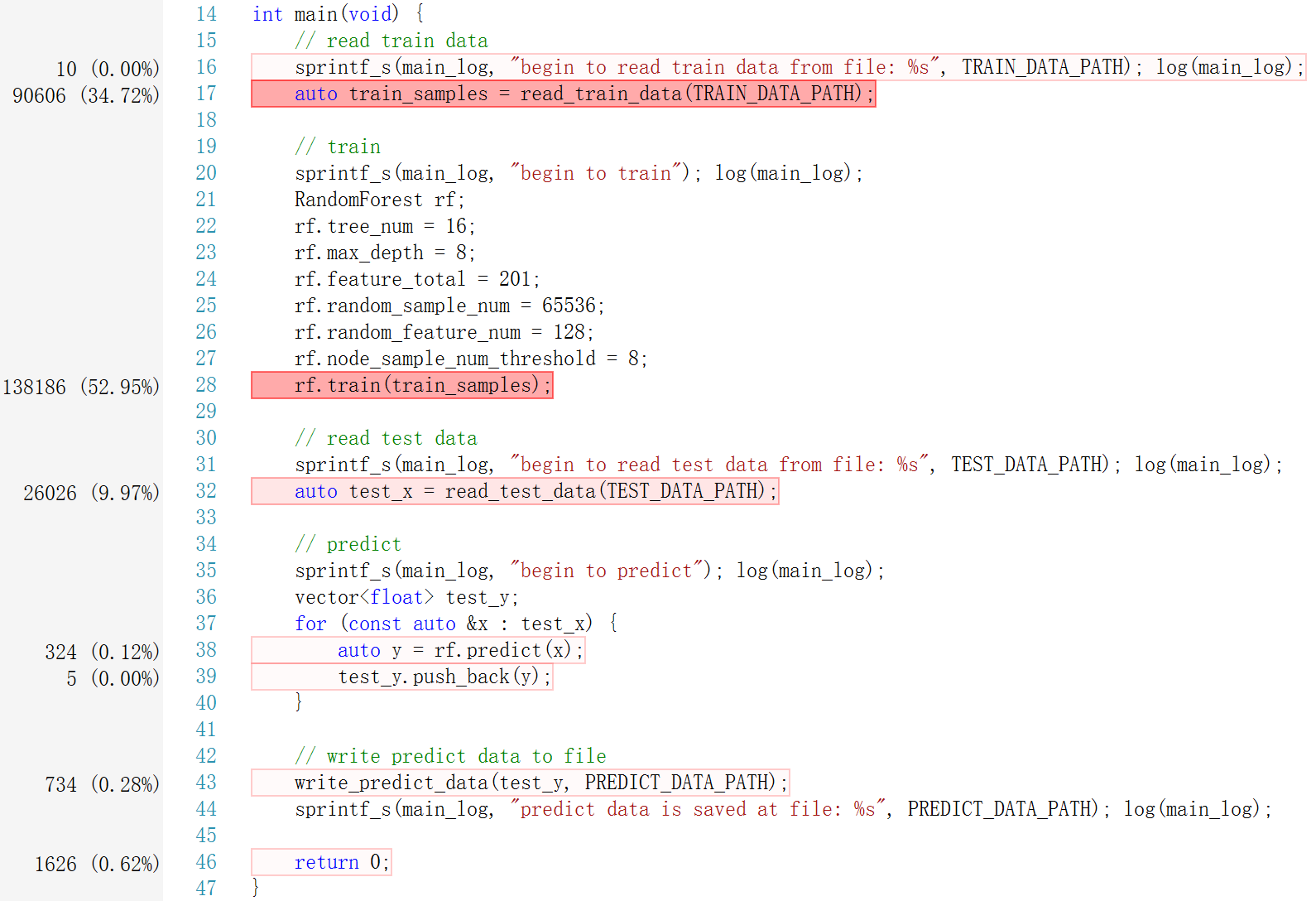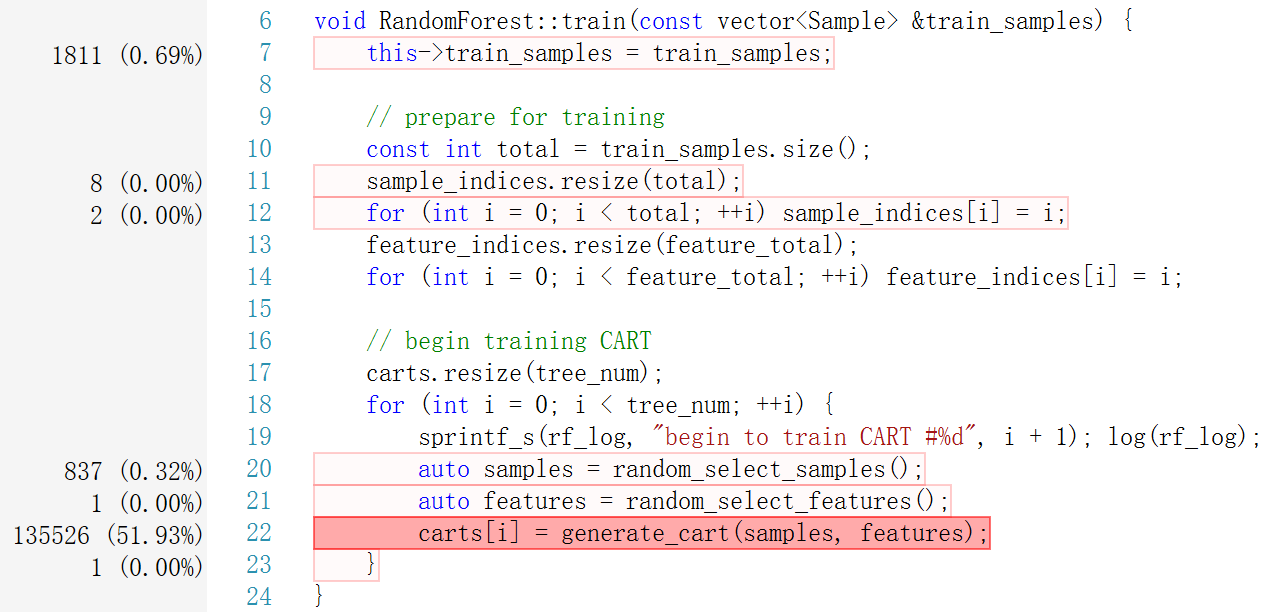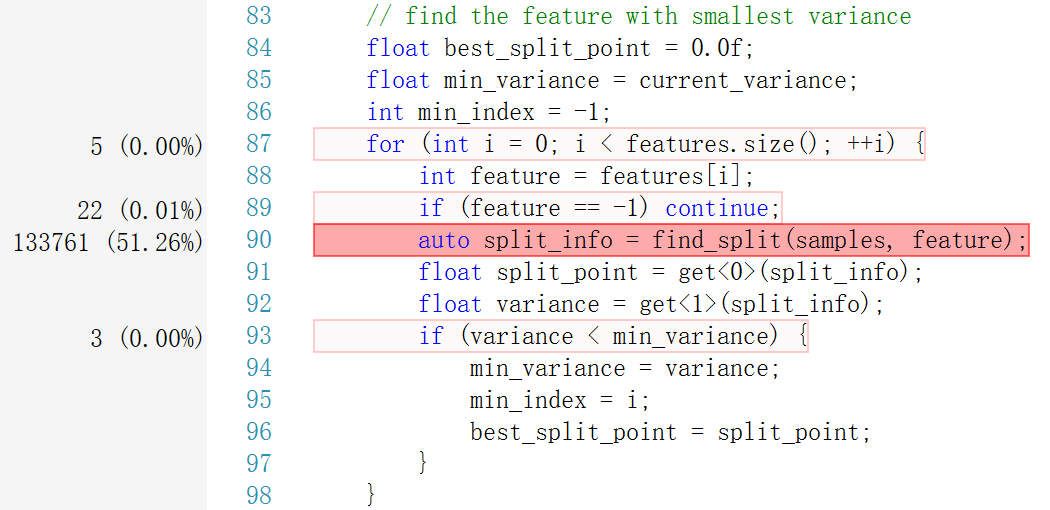随机森林实现与优化报告
郑钊 15331424 计算机应用
2018-07-15
[TOC]
1. 实验简介
1.1. 开发环境
- Intel(R) Core(TM) i7-5557U
- 8.00 GB RAM
- Windows 10 Pro
- Visual Studio 2017
1.2. 运行程序
-
使用 VS2017 打开
random-forest.sln。 -
修改
main.cpp中下列三者为相应的路径。
TRAIN_DATA_PATH:训练数据文件的路径TEST_DATA_PATH:测试数据文件的路径PREDICT_DATA_PATH:测试结果文件的路径
- 设置
main.cpp中的训练参数。
tree_num:CART 总数max_depth:CART 最大深度feature_total:特征总数random_sample_num:每次随机抽取样本的数目random_feature_num:每次随机抽取特征的数目node_sample_num_threshold:CART 节点样本数目的最小值
推荐的参数为:
rf.tree_num = 16;
rf.max_depth = 8;
rf.feature_total = 201;
rf.random_sample_num = 65536;
rf.random_feature_num = 128;
rf.node_sample_num_threshold = 8;-
菜单栏->调试->开始执行(不调试)。 -
最终输出的预测结果文件在
PREDICT_DATA_PATH对应的路径
2. 实现
2.1. 随机森林原理
随机森林是一种典型的树集成算法,是基于不同的样本、不同的特征训练出 N 颗 CART。本次实验项目虽然是一个二分类的问题,但是由于 Kaggle 上要求的是预测测试样本为正的概率,所以我们这次实验要构造的 CART 不是分类树,而是回归树。随机森林对 N 颗 CART 的回归结果取均值作为最终的预测概率。
CART(分类回归树)是一种二分决策树(既能是分类树,又能是分类树)。其在构建的过程中,每次对特征进行切分后只会产生两个子节点,CART 分裂时:
- 如果 CART 是分类树,采用 GINI 值作为节点分裂的依据;
- 如果 CART 是回归树,采用样本的最小方差作为节点分裂的依据。
上面已经说了,我们要构造的是 CART 回归树,所以在分裂节点的时候参考的依据是样本的最小方差。
2.2. 训练算法
-
随机抽取 n 个样本
-
随机抽取 k 个特征
-
基于 1, 2 抽取的样本、特征,训练出一颗 CART
-
对于 k 个特征,找出每个特征的最佳分裂点以及对应分裂后的样本均方差
-
选择分裂后样本均方差最小的特征进行分裂
-
重复 1, 2 直到:
+ 节点的深度达到预设的最大深度 `max_depth`
+ 节点中的样本数目小于预设的阈值 `node_sample_num_threshold`
+ 分裂后的样本均方差大于或等于分裂前的样本方差(没必要再分裂)
- 重复 1, 2, 3 直到训练出预设数量的 CART 集合
2.3. 代码设计
基于数据结构
X,Y,Sample和Node,在RandomForest中构造CART集合。
2.3.1. 数据结构
typedef vector<float> X;typedef bool Y;typedef struct {
X x;
Y y;
} Sample;struct Node {
int feature;
float value;
float split_point;
Node *left;
Node *right;
Node() {
feature = -1;
value = false;
split_point = 0.0f;
left = NULL;
right = NULL;
}
bool is_leaf() const {
return left == NULL && right == NULL;
}
};2.3.2. CART
struct CART {
Node *root;
// constructor
CART() {
root = NULL;
}
// classify
float classify(const X &x) const {
Node *node = root;
while (!node->is_leaf()) { // while not a leaf node
if (node->left == NULL) node = node->right;
else if (node->right == NULL) node = node->left;
else node = x[node->feature] <= node->split_point ? node->left : node->right;
}
return node->value;
}
};2.3.3. RandomForest
class RandomForest {
public:
// params
int tree_num; // CART 总数
int max_depth; // CART 最大深度
int feature_total; // 特征总数
int random_sample_num; // 每次随机抽取样本的数目
int random_feature_num; // 每次随机抽取特征的数目
int node_sample_num_threshold; // CART 节点样本数目的最小值
// public methods
void train // 训练
(const vector<Sample> &train_samples);
float predict // 预测
(const X &x);
private:
// train data
vector<Sample> train_samples; // 训练样本
vector<int> sample_indices; // 训练样本索引(用于随机抽取样本)
vector<int> feature_indices; // 特征索引(用于随机抽取特征)
// models
vector<CART> carts; // CART 集合
// private methods
vector<Sample*> random_select_samples // 随机抽取 random_sample_num 个样本
(void);
vector<int> random_select_features // 随机抽取 random_feature_num 个特征(0~200)
(void);
CART generate_cart // 训练一颗 CART
(vector<Sample*> &samples, vector<int> &features);
void split_node_recursively // 递归地分裂节点
(vector<Sample*> &samples, vector<int> &features, Node *&node, const int depth);
tuple<float, float> find_split // 找到一组特征中的最佳分割点
(vector<Sample*> &samples, const int feature);
float compute_variance // 计算样本方差
(const vector<Sample*> &samples);
void sort_on_feature // 将样本基于某个特征进行排序
(vector<Sample*> &samples, const int feature);
};3. 并行优化
3.1. 非并行版本
可以看到,整个程序的运行,除去读取数据的时间消耗之外,绝大多数的时间用在 train 上。
在 train 中,近一半的时间用于寻找最佳分割点 find_split。另外,值得一提的是,由于我是通过深度优先的方式构建 CART,随意分裂左节点消耗的时间会多于分裂右节点。
3.2. 并行优化
并行化分析:
- 随机森林最大的特点就是 CART 之间是两两独立的,所以并行化的第一个思路就是并行地生成每一颗 CART。
- 另外,在生成每一颗 CART 的过程中,每个特征找最佳分割点的过程,也可以并行化。
3.2.1. 并行生成 CART
omp_set_num_threads(4);
#pragma omp parallel for
for (int i = 0; i < tree_num; ++i) {
sprintf_s(rf_log, "CART #%d begin to train in thread #%d", i + 1, omp_get_thread_num()); log(rf_log);
auto samples = random_select_samples();
auto features = random_select_features();
carts[i] = generate_cart(i + 1, samples, features);
}开始训练,这里对比一下非并行化版本、4-thread 和 8-thread 的区别:
- 对比非并行化版本和 4-thread 可以发现:在并行化前后的 CPU 使用率和训练时间差别很大,并行化能带来约 50% 的训练速度提升!
- 对比 4-thread 和 8-thread 可以发现:后者的性能提升相比较于前者并不明显,因此没有必要开 8-thread。
3.2.2. 并行寻找最佳分割点
#pragma omp parallel for
for (int i = 0; i < features.size(); ++i) {
int feature = features[i];
if (feature == -1) continue;
auto split_info = find_split(samples, feature);
float split_point = get<0>(split_info);
float variance = get<1>(split_info);
if (variance < min_variance) {
min_variance = variance;
min_index = i;
best_split_point = split_point;
}
}这里优化之后,对训练时间的优化几乎可以忽略,这是因为前面 3.2.1 中的并行优化已经饱和了。
4. Cache 友好优化
这里在代码中的体现主要是通过样本索引的打乱来体现的,优化之后性能上的提升也是几乎可以忽略不计的,这里就不展示。
void shuffle(vector<int> &cards) {
srand(time(NULL));
int n = cards.size();
for (int i = 0; i < n; ++i) {
int index = rand() % (n - i) + i;
if (index != i) {
int tmp = cards[i];
cards[i] = cards[index];
cards[index] = tmp;
}
}
}
vector<Sample*> RandomForest::random_select_samples(void) {
vector<Sample*> samples;
// shuffle
shuffle(sample_indices);
const int total = train_samples.size();
const int begin = rand(0, total);
for (int i = 0; i < random_sample_num; ++i) {
int j = sample_indices[(begin + i) % total];
samples.push_back(&train_samples[j]);
}
return samples;
}5. 预测结果
- 之前基于 xgboost 的 Kaggle 得分:
0.89812 - 本算法的 Kaggle 得分:
0.87472










